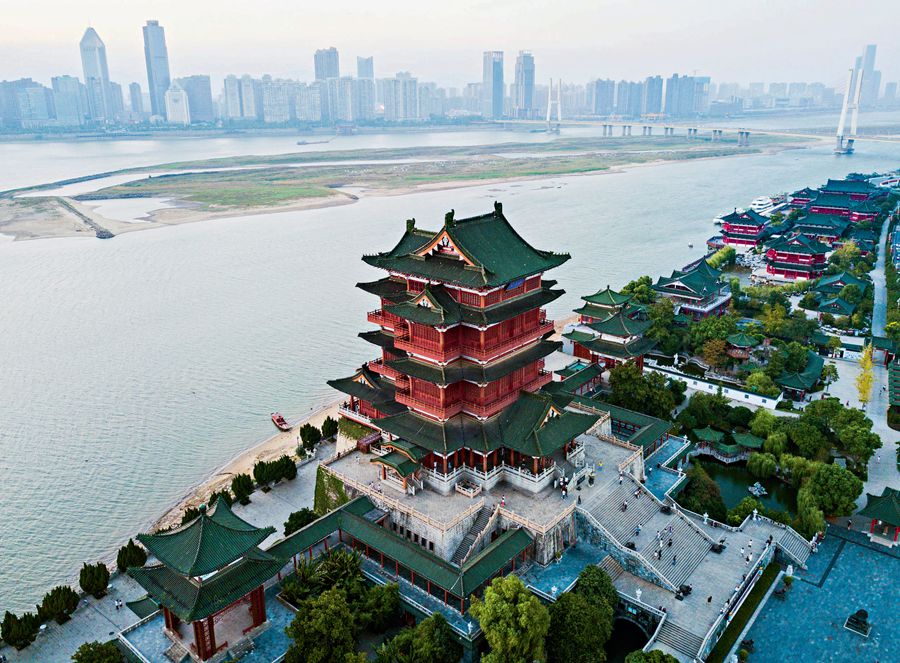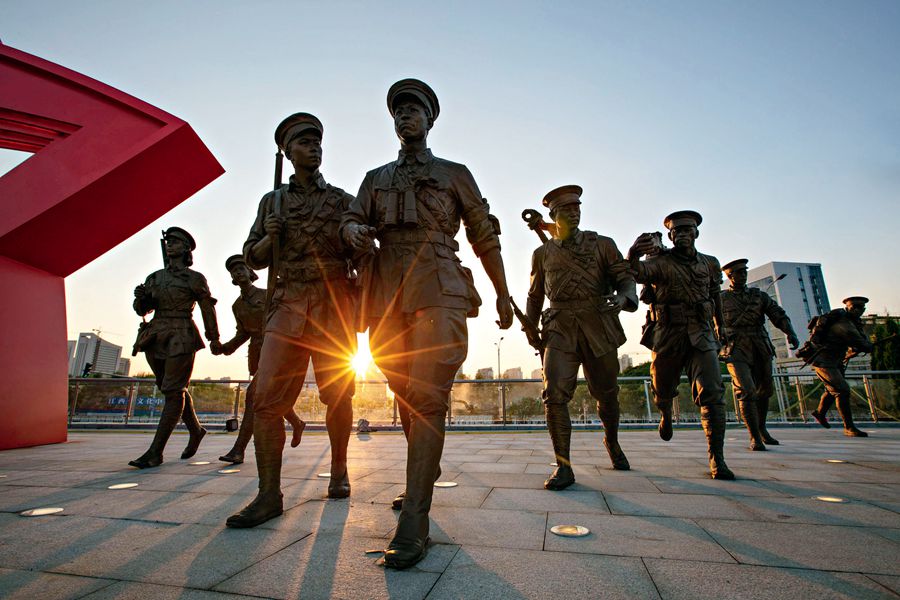NANCHANG is the capital of Jiangxi Province. More than 1,300 years ago, Preface to Tengwang Pavilion, a poem by Wang Bo of the Tang Dynasty, made the city famous nationwide. Ninty-one years ago, the Nanchang Uprising gave birth to the Chinese People’s Liberation Army (PLA).
After the founding of the People’s Republic of China in 1949, Nanchang was the earliest aviation industry base. The first China-made aircraft, the first batch of coastal defense missiles, and the first motorcycles were built here. In the new century, the photoelectronic industry in Nanchang continued to develop rapidly and has become a photoelectronic information industrial base with significant influence throughout the country.

Tengwang Pavilion.
As a famous historic and cultural city, Nanchang also has beautiful natural scenery and numerous cultural sites. It is close to the famous world cultural heritage site, the Lushan National Scenic Area, the communist tourist destination Jinggang Mountain National Scenic Area, and the world-famous porcelain city Jingdezhen, which is a must-see for travelers to Jiangxi.
Prosperity of Traditional Taoism
The history of Nanchang can be traced back to 202 BC. Emperor Liu Bang of the Han Dynasty (206 BC - 220 AD) sent troops there to build a city (about four kilometers southeast of Nanchang Railway Station), taking the name of Nanchang, meaning “Southern Prosperity.” Around the third century, along with the spread of the Central Plains culture, Nanchang developed greatly and gradually became an important city on the Chinese territory. At that time, China was in the period of ethnic integration, and culture was diversified. Philosophy, literature, and art all underwent innovations. Taoism developed from local ideas is one of them.
As a school of thought, Taoism advocates naturism, has dialectical factors and atheistic tendencies, and calls for harmony with nature. Being broad and inclusive, Taoism stands for inaction and opposes conflict. Taoists prefer to practice in the mountains to get close to nature. There are many famous mountains and rivers in Jiangxi, which provide conducive conditions and an environment for the existence and growth of Taoism. The Longhu Mountain, a world natural heritage 170 kilometers east of Nanchang, is the birthplace of Chinese Taoism.

The Army Building Sculpture Square in Nanchang Fenghuangzhou Citizen Park.
Born in Nanchang, Xu Xun is one of four Taoist masters. He showed great talent since young age, had broad learning and good memory, and liked to practice Taoism. He hoped to use the Taoism to prevent malpractices in politics. When he was a county magistrate, he was incorruptible, and he also taught locals to plant trees, cultivate water sources, and take measures to resist floods, winning the love of the people. Legend goes that he lived to a ripe old age of 135 years, and eventually ascended to heaven, even taking his poultry and livestock, leading to a saying in China that “when a man gets to the top, all his friends and relations get there with him.”
After his death, his descendants built a memorial temple in his old residence. In the Song Dynasty (960-1279), Emperor Huizong highly praised Taoism and personally wrote the name for Yulong Longevity Palace, which commemorates Xu Xun. The palace is located in Xishan Town, 30 kilometers southwest of Nanchang City. It is still a place for monastic training. Every year, the 27th day of the first month of the lunar calendar, the birthday of Xu Xun, and the day he ascended to heaven in the eighth month of the lunar calendar, the local believers come to pray. The palace covers an area of 31,000 square meters. The sculptures are exquisite and have the characteristics of the times. There are also a large number of auxiliary buildings outside the palace, forming a group of ancient buildings centered on the palace.
Longevity palace is also the spiritual abode of the locals. If a Jiangxi migrant has a certain level of available financial resources, one can build a longevity palace in the same pattern. It commemorates Xu Xun, the cultural idol of Jiangxi’s ancient residents, and also provides a meeting place for the people of Jiangxi living out of the region. They have also become the “Jiangxi Guild Hall” for merchants from Jiangxi. According to incomplete statistics, there are more than 1,400 longevity palaces in the world, covering more than 20 regions including Hong Kong, Macao, Taiwan, and some Southeast Asian countries such as Singapore, Malaysia, and Thailand.
Birthplace of the PLA
August 1 of each year is the anniversary of the founding of the Chinese People’s Liberation Army (PLA), which is derived from the August 1st Nanchang Uprising in 1927.
Starting at 2 o’clock on the morning of August 1, 1927, the uprising opened the prelude of the Communist Party of China’s (CPC) independent leadership of armed struggle and the creation of a revolutionary army. Although the uprising ended in failure, and the uprising army of 22,000 people ended up with only 800 people, this 800-person team became the foundation for the establishment of the PLA. Zhu De, the leader of this team, also became one of the main founders and leaders of the PLA. He was the commander-in-chief of the Chinese Workers’ and Peasants’ Red Army, the Eighth Route Arm, and the PLA. In 1955, the PLA appointed 10 marshals for the first time, eight of whom were directly or indirectly involved in the Nanchang Uprising.
There are many places in Nanchang named after the “August 1st” (bayi in Chinese pinyin) – Bayi School, Bayi Bridge, Bayi Avenue, Bayi Park, Bayi Square... The August 1st Nanchang Uprising Memorial Tower attracts a number of domestic and foreign tourists every day.
In the modern history of China, Jiangxi has a special status as revolutionary stronghold. On this land are the cradle of the Chinese revolution – Jinggang Mountain, the cradle of the PRC – Ruijin, the place where the people’s army flag was raised – Nanchang, the source of the Chinese workers’ movement – Anyuan. A series of major revolutionary events took place in Jiangxi, which is like a revolutionary historical museum. The revolutionary sites, former residences of revolutionists, and memorial buildings are numerous and widely distributed.
In 2000, Jiangxi began to build a red tourist area, becoming a unique resource advantage for Jiangxi tourism. The famous mountains and rivers there have witnessed the history of the Chinese revolution, to name some: the former site of Zhu De Military Academy, Shangrao Concentration Camp, Anyuan Coal Miners’ Movement Memorial Hall, Autumn Harvest Uprising Square, Red Army Long March Departure Site, site of the CPC Soviet government and other government functional departments, the Jinggang Mountain Revolutionary Base, and the former Lushan Conference site.
Aviation Industrial Base
On July 3, 1954, the CJ-5, the first aircraft built by the PRC, flew into the blue skies over Nanchang. On May 5, 2017, the C919, China’s first domestically-built large passenger jet, landed safely at Shanghai Pudong International Airport. Its front fuselage and mid-rear fuselage were manufactured in Nanchang.
Jiangxi is one of China’s major aviation industrial research and production bases. As the cradle of the PRC’s aviation industry, the province is the hub for the development and production of Chinese helicopters and training planes. The scale of its aviation manufacturing has always ranked among the top four in China. In well-known aviation exhibitions and major military parades at home and abroad, planes developed and produced by Jiangxi are common, such as the L15 Falcon trainer jet, AC313 large civil helicopter, and CAIC Z-10 armed helicopter. Jiangxi has a relatively complete product portfolio such as trainer aircraft, strike aircraft, helicopters, unmanned aerial vehicles, and large aircraft components, and has formed a strong capacity for aviation product design, testing, advanced manufacturing, and assembly.
Nanchang builds aviation as a strategic emerging industry that supports the city’s economic transformation and upgrading, and has achieved leapfrog development. In May, the single-engine, four-seat fixed-wing general-purpose plane GA20 that has been independently developed by a private enterprise was successfully launched in Nanchang National High-Tech Industrial Development Zone. Just 10 days later, the country’s fifth airworthiness certification center was unveiled in Nanchang. In June, the Nanchang Yaohu Airport, with a total investment over RMB 1.65 billion, ushered in its first flying test.
The city has taken the building of the comprehensive demonstration zone for the national general aviation industry as an opportunity to become a large aviation industrial hub, integrating aviation manufacturing, aviation logistics, general aviation, and airport economy. Meanwhile, it has undertaken the large aircraft project as an opportunity to further attract aviation industry projects. Up to now, Nanchang has welcome in 18 aviation enterprises, and formed an aviation industrial base pattern with large aircraft manufacturing research and development as the main focus, with core components such as complete machine and engine as the foundation, supplemented by aviation and aerospace research and public services.
The development of the aviation industry helps Jiangxi tourism. From the Nanchang Changbei International Airport, Jiangxi has formed six tourist routes that cover the Jinggang Mountain, Lushan Mountain, and Jingdezhen, thus providing great convenience for tourists in transportation.
(Compiled by China Today)

